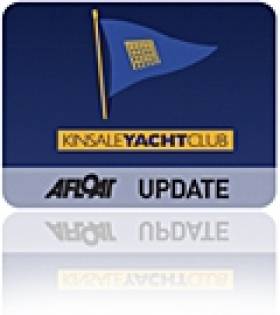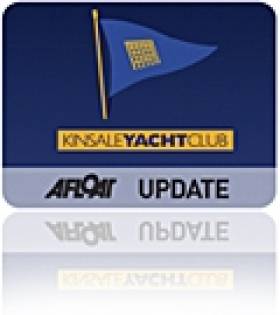Displaying items by tag: Cameron Good
Thirty Enjoy Kinsale's Frostbite Finale
Conditions for the final day of the ASM-Marine Frostbite League at Kinsale Yacht Club on Sunday could not have been a more inviting finale for the thirty plus sailors competing in the Laser, Squib and Mixed Dinghy Fleets. Despite losing two of the six week series due to the weather, the last day of the season brought welcome sunshine accompanied by a fresh Force 4 North to North-Westerly breeze, gusting Force 5 at times. Three windward-leeward races were completed which brought the total race number to eleven, with two discards applying. The constantly shifting Northerly breeze, which tracked slowly westwards was the predominate feature in all three races, with an ebb tide having effect to the right hand side of the coarse.
Dara O'Shea (KYC) with another gritty performance in the Laser 4.7 fleet, managed this week to overhaul the league leader Cian Byrne (KYC/RCYC). Leaving it to the final race and with both sailors on nineteen points, Dara grasped the top spot as he fought off his rivals and eventually took line honours and the Laser 4.7 League title. Cian untypically finished fourth but nevertheless secured second place overall, just two points behind. Darragh O'Sullivan had an excellent day's racing with a win and two seconds which pulled him into third place overall, just ahead of Conor Murphy (KYC) who finished on the same points total but one place behind in the final race.
Proving once again that consistency is the key to success in the Frostbite League, Eoghan Cudmore (KYC) with a fifth, third and a second in the Radial Fleet managed to hold off the challenge for the top spot from last year's winner Sean Murphy (KYC) who scored two thirds and a fourth. With the second best results of the day, Colm O'Regan (KYC) scoring two seconds and a fourth, moved up to third place overall. Despite an excellent run of results with three wins on the final day Thomas Chaix (KYC) with insufficient points accrued could not make an impact on the final order.
In the Laser Standard Class Rob Howe (RCYC) continued his outstanding form with a further second place and two firsts bringing his overall total to an unassailable eleven points, fourteen points ahead of his nearest rival Paul O'Sullivan of Monkstown. Scoring two thirds and a second, O'Sullivan's consistent form paid off bringing him into second place overall. David Kenefick (RCYC) who had closely pursued the leader throughout the series, dropped to third place overall as he did not compete on the day.
Seldom conceding line honours Marcus Hutchinson and Ben Fusco (KYC) in the Squib Class went into the final day leading comfortably by eight points. Two wins later and a final second easily secured the league title and are now the new holders of the Bruce Mathews Squib Trophy. In a repeat of last year Paul McCarthy (KYC) finished strongly with two seconds and a win in the final race. These results elevated him from fourth place overall into the prize winning second position. Victor Fusco and Ruth Ennis (KYC) with a final third, fourth and seventh subsequently slipped one place to claim the third prize overall.
In the Mixed Dinghy Class, despite conceding line honours in all three races Brian Jones and Gary Frost (MBSC) in their International 505 finished the series as the lead boat four points comfortably ahead. The RS Feva of David Marshall and Rob Scandrett (RCYC) closed on a high note as they took advantage with three win ASM-Marine KYC Frostbite League - Sunday 27th Feb, 2011.
Conditions for the final day of the ASM-Marine Frostbite League at Kinsale Yacht Club on Sunday could not have been a more inviting finale for the thirty plus sailors competing in the Laser, Squib and Mixed Dinghy Fleets. Despite losing two of the six week series due to the weather, the last day of the season brought welcome sunshine accompanied by a fresh Force 4 North to North-Westerly breeze, gusting Force 5 at times. Three windward-leeward races were completed which brought the total race number to eleven, with two discards applying. The constantly shifting Northerly breeze, which tracked slowly westwards was the predominate feature in all three races, with an ebb tide having effect to the right hand side of the coarse.
Dara O'Shea (KYC) with another gritty performance in the Laser 4.7 fleet, managed this week to overhaul the league leader Cian Byrne (KYC/RCYC). Leaving it to the final race and with both sailors on nineteen points, Dara grasped the top spot as he fought off his rivals and eventually took line honours and the Laser 4.7 League title. Cian untypically finished fourth but nevertheless secured second place overall, just two points behind. Darragh O'Sullivan had an excellent day's racing with a win and two seconds which pulled him into third place overall, just ahead of Conor Murphy (KYC) who finished on the same points total but one place behind in the final race.
Proving once again that consistency is the key to success in the Frostbite League, Eoghan Cudmore (KYC) with a fifth, third and a second in the Radial Fleet managed to hold off the challenge for the top spot from last year's winner Sean Murphy (KYC) who scored two thirds and a fourth. With the second best results of the day, Colm O'Regan (KYC) scoring two seconds and a fourth, moved up to third place overall. Despite an excellent run of results with three wins on the final day Thomas Chaix (KYC) with insufficient points accrued could not make an impact on the final order.
In the Laser Standard Class Rob Howe (RCYC) continued his outstanding form with a further second place and two firsts bringing his overall total to an unassailable eleven points, fourteen points ahead of his nearest rival Paul O'Sullivan of Monkstown. Scoring two thirds and a second, O'Sullivan's consistent form paid off bringing him into second place overall. David Kenefick (RCYC) who had closely pursued the leader throughout the series, dropped to third place overall as he did not compete on the day.
Seldom conceding line honours Marcus Hutchinson and Ben Fusco (KYC) in the Squib Class went into the final day leading comfortably by eight points. Two wins later and a final second easily secured the league title and are now the new holders of the Bruce Mathews Squib Trophy. In a repeat of last year Paul McCarthy (KYC) finished strongly with two seconds and a win in the final race. These results elevated him from fourth place overall into the prize winning second position. Victor Fusco and Ruth Ennis (KYC) with a final third, fourth and seventh subsequently slipped one place to claim the third prize overall.
In the Mixed Dinghy Class, despite conceding line honours in all three races Brian Jones and Gary Frost (MBSC) in their International 505 finished the series as the lead boat four points comfortably ahead. The RS Feva of David Marshall and Rob Scandrett (RCYC) closed on a high note as they took advantage with three wins and claimed the second prize overall. Finishing third on the day and third overall in the series was the Feva of Fiona Lynch and Sofie Kelleher.
At the Prize Giving, Alice Kingston KYC Commodore, congratulated the deserving winners and thanked all the sailors for their efforts. Special thanks went to PRO Bruce Mathews for his dedicated support, the Organisers, the Sponsor ASM-Marine and all those who had helped both on and off the water to make this annual event such a success. Cameron Good KYC Vice-Commodore presented the prizes and June Matthews presented the Bruce Matthews Trophies for the best performances in the Laser Radial and Squib Classes won by Eoghan Cudmore and Marcus Hutchinson respectively. The inaugural Laser 4.7 'Destiny' Trophy was presented to Dara O'Shea.
- ASMMarine
- Kinsale
- yacht
- Club
- Frostbite
- Dara O'Shea
- Cian Byrne
- Darragh O'Sullivan
- Conor Murphy
- Eoghan Cudmore
- Colm O'Regan
- Sean Murphy
- Ben Fusco
- Marcus Hutchinson
- squib
- Paul McCarthy
- Ennis
- Ruth
- Dinghy
- Cameron Good
- Ruth Ennis
- Fiona Lynch
- Sofie Kelleher
- David Marshall
- Laser
- David Kenefick
- RCYC
- Royal Cork
Dragons Prepare for South Coasts in Kinsale
Kinsale Yacht Club hosts the Irish Dragon South Coast Championships from 10 - 12 September 2010.
A very competitive fleet of 18 Dragons will assemble in Kinsale this weekend for the final Championship of the Irish calendar with both the South Coast title and
valuable ranking points for both the World and European Championship qualification on offer.
Though this is a helmsman's championship the importance of an established and cohesive crew on a Dragon is crucial when determining favorites. Neil Hegarty, Peter Bowring and David Willams (Phantom) have excelled on the waters under the Old Head in recent years taking two consecutive National Championships in 2007 and 2009. However, they have always been pushed hard by Martin Byrne (Jaguar) who won the last edition of the South Coast Championships held in Kinsale in 2008 with his son Conor and constant collaborator Pedro De Andrade. Along with several other stellar teams from both the Royal St George and the Royal Irish, including current National Champion Don O'Donoghue (Seabird), is perennial favorite Simon Brien (Kin) from the Royal North of Ireland.
Kinsale Yacht Club has been selected to host the Dragon Gold Cup 2012 and the Kinsale Dragon fleet will be hoping to end the Dun Laoghaire domination of
recent years.
Olaf Sorensen, Martin Payne and Shawn Kingston (Christianna) will lead the challenge with Cameron Good, Henry Kingston and Simon Furney (Little Fella) another long-established team pushing hard for a breakthrough this year. Class Captain Anthony O'Neill with Donal Small and his son Eoghan (Tenacious) have sailed consistently well this season however; Tim Cronin, Caroline Matthews and Harry Lewis (Jee) have found a rich vein of form following a prolonged lay-off and could prove the surprise package.
The courses will be Windward-Leeward and six races will be sailed, with two races each day back to back. Friday promises very interesting conditions with fresh to strong southwesterly winds though the breeze set to moderate throughout the weekend. Principal Race Officer Alan Crosbie and his team will commence proceedings on Friday morning with another scintillating Dragon regatta in prospect.
- Martin Byrne
- Kinsale Yacht Club
- Irish Dragon South Coast Championships
- Neil Hegarty,
- Peter Bowring
- David Willams
- Pedro De Andrade
- Don O'Donoghue
- Simon Brien
- Olaf Sorensen
- Martin Payne
- Shawn Kingston
- Tim Cronin
- Caroline Matthews
- Harry Lewis
- Alan Crosbie
- Henry Kingston
- Cameron Good
- Simon Furney
- Dragon Gold Cup 2012






























































